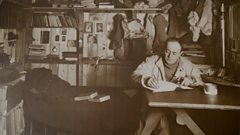
Modern Times
Andrew Graham-Dixon reveals how women, both queens and consorts, made their mark on the Collection and used art to steady the ship of monarchy through an uncertain age.
Andrew Graham-Dixon explores how royal collecting has changed since the days of Queen Victoria. This is a story of the British monarchy's remarkable survival, while elsewhere the crown heads of Europe crumbled in the face of world wars and revolutions. But it is also an age when women took charge of royal collecting; from Victoria to Elizabeth II, queens and queen consorts have used art to steady the ship of monarchy during this uncertain age.
It's one of the curiosities of the Royal Collection that as the monarchy's power diminished, so too did the objects they collected. Gone were epic canvases, instead came objects of exquisite, delicate and intimate beauty. Andrew marvels at a selection of the royal family's collection of Faberge jewellery - one of the greatest in the world - that includes the Mosaic Egg from 1914. So taken were Edward VII and his wife Queen Alexandria with the works of Peter Carl Faberge, that the jeweller opened a London shop to service the demands of royal clientele.
And then there's Queen Mary's Dolls' House - presented to George V's queen to thank her for her steadfastness during the first world war, the Dolls' House is an astonishing artistic collaboration by over 1,500 people and companies, replete with books containing new stories by authors like Arthur Conan Doyle, tiny champagne bottles filled with real champagne and even mini shotguns that can be broken, loaded and fired. More than just a dolls' house, this is a three-dimensional archive of a vanished artistic age.
The Collection reveals fresh insights into these remarkable women, in particular HM the Queen Mother, who loved art and collected with flair. At Clarence House, Andrew discovers a surprising collection of contemporary British art that she assembled in the 1930s and 1940s, including works by Walter Sickert, LS Lowry, Paul Nash and Augustus John. Andrew traces her greatest commission, a series of 26 paintings of Windsor Castle by John Piper, painted during the Second World War. With Windsor at risk of being bombed, Piper created an eerie dreamscape filled with black skies and foreboding.
Andrew also brings royal collecting up to date. From the outset Elizabeth II's priorities had been focused on preserving and displaying the Collection, and Andrew shows how one of the key events in its recent history - the Windsor Castle fire - was an unlikely catalyst in the reform of the Collection's care. Concluding his exploration, Andrew meets HRH the Prince of Wales to view two of his recent commissions, powerful portraits of veterans of the Battle of Britain and the D-Day landings, and to discuss the continued importance of this remarkable collection.
Last on
More episodes
Previous
Next
You are at the last episode
See all episodes from Art, Passion & Power: The Story of the Royal Collection
Clips
-
![]()
The Princess in the Picture
Duration: 01:37
-
![]()
A World on the brink
Duration: 02:06
-
![]()
Queen Mary's dolls' house
Duration: 02:52
-
![]()
Web exclusive: Photographs of Antarctica
Duration: 02:52
Music Played
-
![]()
Dmitry Shostakovich
Suite For Jazz Orchestra No 1 Op 38
Credits
| Role | Contributor |
|---|---|
| Presenter | Andrew Graham-Dixon |
| Expert | Caroline de Guitaut |
| Expert | Sophie Gordon |
| Expert | Kathryn Jones |
| Expert | Kajal Meghani |
| Expert | Rosie Razzall |
| Interviewed Guest | Jonathan Marsden |
| Interviewed Guest | HRH The Prince of Wales |
| Executive Producer | Judith Winnan |
| Series Producer | Sebastian Barfield |
| Director | Sebastian Barfield |
| Editor | Stuart Davies |
| Editor | Natasha Martin |
| Production Manager | Kate Horvath |
| Production Manager | J Ruth Stevens |
| Production Coordinator | Sam Haines |
| Colourist | Blair Wallace |
| On-line editing | Jon Ramsey |
Broadcasts
Featured in...
![]()
Art, Passion & Power
Andrew Graham-Dixon explores the history of the Royal Collection.
Royal Collection season
Queen Victoria's watercolour albums
These albums became precious mementos for Victoria after the untimely death of Albert
George III's 'Buy British' drive for the royal art collection
The family retreat at Buckingham House was filled with works by British artisans.
The Curators: Hans Holbein
Insights into Holbein's series of portraits bringing the court of Henry VIII to life.







